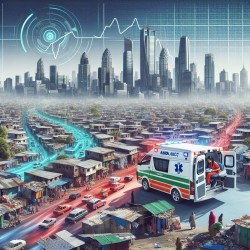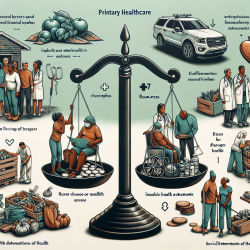Understanding the Impact of Traffic and Socioeconomic Factors on Emergency Care Access in Nairobi
In the bustling city of Nairobi, Kenya, accessing emergency healthcare can be a race against time. A recent study titled "Impact of traffic, poverty and facility ownership on travel time to emergency care in Nairobi, Kenya" sheds light on the challenges faced by residents in reaching healthcare facilities promptly. This blog will explore how practitioners can use the findings from this research to improve their services and encourage further exploration into this critical issue.
The Study's Key Findings
The research conducted a detailed analysis of travel times to different levels of healthcare facilities in Nairobi under both congested and uncongested traffic conditions. Here are some key insights:
- Average travel time to level 4 health facilities (primary hospitals) during uncongested conditions is approximately 4.5 minutes, which increases by 200% during traffic congestion.
- Travel times to level 5 (secondary hospitals) and the level 6 facility (Kenyatta National Hospital) are significantly longer, with congestion adding 166% and 138% to travel times, respectively.
- Poverty plays a crucial role, with individuals below the poverty line facing a 65% increase in travel time when using public or faith-based facilities.
Implications for Practitioners
Understanding these dynamics is crucial for healthcare practitioners aiming to improve emergency care access. Here are some actionable steps:
- Data-Driven Decision Making: Use geographic and traffic data to optimize ambulance routes and reduce response times.
- Facility Planning: Advocate for the strategic placement of new healthcare facilities in underserved areas to minimize travel times for impoverished communities.
- Policy Advocacy: Engage with policymakers to improve urban planning and traffic management, ensuring quicker access to emergency services.
Encouraging Further Research
This study highlights the importance of continuous research in understanding and addressing the barriers to timely emergency care. Practitioners are encouraged to:
- Conduct localized studies to identify specific choke points in traffic and propose targeted interventions.
- Collaborate with urban planners and policymakers to design cities that facilitate faster emergency response times.
- Explore innovative solutions such as telemedicine and mobile clinics to provide immediate care in traffic-prone areas.
Conclusion
By leveraging the findings of this study, practitioners can play a pivotal role in enhancing emergency care access in Nairobi. The combination of data-driven strategies and collaborative efforts with policymakers can lead to significant improvements in healthcare outcomes for all residents, especially those most vulnerable.
To read the original research paper, please follow this link: Impact of traffic, poverty and facility ownership on travel time to emergency care in Nairobi, Kenya.










